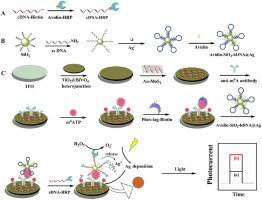Biosensors and Bioelectronics ( IF 10.7 ) Pub Date : 2018-02-27 , DOI: 10.1016/j.bios.2018.02.056 Haiyan Wang 1 , Huanshun Yin 1 , Hua Huang 1 , Kelin Li 2 , Yunlei Zhou 1 , Geoffrey I N Waterhouse 3 , Hai Lin 2 , Shiyun Ai 1

|
Herein, a novel dual-signal amplified photoelectrochemical (PEC) biosensor was successfully developed for the highly selective detection of N6-methyladenosine (m6A) methylated RNA. The PEC biosensor comprised BiVO4–110-TiO2 heterojunction and gold nanoparticle decorated MoS2 (MoS2-AuNPs) as the photoactive materials, horseradish peroxidase conjugated biotin (HRP-Biotin) as the enzymatic unit, Ag+-mediated cytosine pairs (C-Ag+-C) as the signal amplification unit, and the anti-m6A antibody as the m6A methylated RNA recognition unit. Following immunoreaction between m6A and the anti-m6A antibody, the C-Ag+-C structure of the hairpin DNA unfolded, yielding the duplex strand DNA (dsDNA) and releasing Ag+ ions. Superoxide ions (O2-) generated by the action of HRP on H2O2 then served as an electron donor, resulting in the deposition of Ag on AuNPs surface and resulting in an increased photocurrent. Based on this change f the photocurrent, m6A could be accurately assayed using this dual-signal amplified PEC biosensor. The biosensor showed high selectivity and a very low detection limit of 1.665 pM for m6A, and was successfully applied to evaluate the content change of m6A in leaves of maize seedling and chicken fetal hepatocytes samples after treatment with chemical mutagen of ethylmethane sulfonate and hormone of insulin, respectively.
中文翻译:

基于BiVO4-110-TiO2异质结、Ag+介导的胞嘧啶对检测N6-甲基腺苷的双信号放大光电化学生物传感器
在此,成功开发了一种新型双信号放大光电化学 (PEC) 生物传感器,用于高选择性检测 N 6 -甲基腺苷 (m 6 A) 甲基化 RNA。PEC 生物传感器包括 BiVO 4 –110-TiO 2异质结和金纳米粒子装饰的 MoS 2 (MoS 2 -AuNPs) 作为光活性材料,辣根过氧化物酶结合生物素 (HRP-Biotin) 作为酶促单位,Ag +介导的胞嘧啶对 ( C-Ag + -C)作为信号放大单元,抗m 6 A抗体作为m 6 A甲基化RNA识别单元。继 m 6之间的免疫反应A 和抗-m 6 A 抗体,发夹 DNA的 C-Ag + -C 结构展开,产生双链 DNA (dsDNA) 并释放 Ag +离子。HRP 对 H 2 O 2的作用产生的超氧离子 (O 2 - )然后充当电子供体,导致 Ag 在 AuNPs 表面沉积并导致光电流增加。基于光电流的这种变化,可以使用这种双信号放大 PEC 生物传感器准确测定m 6 A。该生物传感器对 m 6 A显示出高选择性和 1.665 pM 的极低检测限,并成功应用于评估 m 6的含量变化分别用甲基磺酸乙酯化学诱变剂和胰岛素激素处理后的玉米幼苗和鸡胎肝细胞样品的叶子中的 A。











































 京公网安备 11010802027423号
京公网安备 11010802027423号